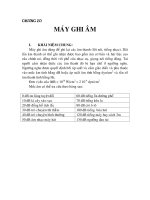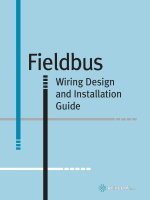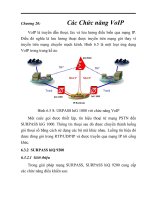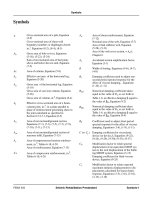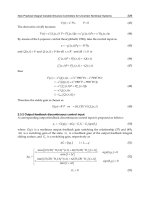Design Realization - lecture 20 docx
Bạn đang xem bản rút gọn của tài liệu. Xem và tải ngay bản đầy đủ của tài liệu tại đây (523.02 KB, 35 trang )
Design Realization
lecture 20
John Canny
10/30/03
Last time
Real-time programming
This time
Mechanics – Physics and Motors
Review of physics
Newton’s law for translation:
F = m a
F in Newtons, m in kg, a in m/s
2
.
Acceleration a = dv / dt
Kinetic energy E = ½ m v
2
E in Joules, m in kg, v in m/s.
Physics of translation
Momentum p = m v and so F = dp / dt
In the absence of force, momentum is
conserved.
Momentum conservation implies energy
conservation.
Physics of rotation
Rotation is more complex; Euler’s equation:
T = I
α
+
ω
x I
ω
T (torque) in N-m,
ω
in radians/sec,
α
in
radians/sec
2
, I in kg-m
2
,
α
= d
ω
/ dt
I is a 3x3 matrix, not necessarily diagonal.
If T = 0, then I
α
= -
ω
x I
ω
which is
usually non-zero. So
α
is non-zero,
ω
changes with time, and the object wobbles.
Physics of rotation
Angular momentum is q = I
ω
The rotation equation simplifies to T = dq / dt
because
dq/dt = I d
ω
/dt + dI/dt
ω
= I
α
+
ω
x I
ω
So even though an object wobbles when
there is no external force, the angular
momentum is conserved: q = I
ω
Physics of rotation
Kinetic energy of rotation is ½
ω
T
I
ω
In the absence of external torque, kinetic
energy of rotation is conserved.
But angular momentum conservation does
not imply energy conservation.
Work
Work done by a force = F x (Joules) where x
is the distance (m) through which the force
acts.
Work done by a torque = T
θ
(Joules)
Power
Power is rate of doing work.
Power of a force = F v (Watts).
Power of a torque = T
ω
(Watts).
Power often expressed in horsepower = 746
Watts
Motors
Motors come in several flavors:
DC motors
Stepper motors
(AC) induction motors
(AC) Single-phase motors
(AC) Synchronous motors
The first two are highly controllable, and
usually what you would use in an application.
But we quickly review the others.
3-phase AC
Three or four wires that carry the same
voltage at 3 equally-spaced phases:
Single phase AC requires two wires (only 1/3
the current or power of 3-phase).
AC induction Motors
Induction motors – simple, cheap, high-power,
high torque, simplest are 3-phase.
Speed up to 7200 rpm: speed ~ 7200 / #
“poles” of the motor.
Induction motors are brushless (no contacts
between moving and fixed parts). Hi reliability.
Efficiency high: 50-95 %
Single-phase AC Motors
Single-phase (induction) motors – operate from
normal AC current (one phase). Household
appliances.
Single-phase motors use a variety of tricks to
start, then transition to induction motor
behavior.
Efficiency lower: 25-60%
Often very low starting torque.
Synchronous AC Motors
Designed to turn in synchronization with the
AC frequency. E.g. turntable motors.
Low to very high power.
Efficiency ??
DC Motors
DC motor types:
DC Brush motor
“DC” Brushless motor
Stepper motor
DC Brush Motors
A “commutator” brings current to the moving
element (the rotor).
As the rotor moves, the polarity changes,
which keeps the magnets pulling the right
way. DEMO
Highly controllable, most common DC motor.
DC Brush Motors
At fixed load, speed of rotation is
proportional to applied voltage.
Changing polarity reverses rotation.
To first order, torque is proportional to
current.
Load curve:
Motors which
approximate this
ideal well are
called DC servo
motors.
DC Brushless Motors
Really an AC motor with electronic
commutation.
Permanent magnet rotor, stator coils are
controlled by electronic switching. DEMO
Speed can be controlled accurately by the
electronics.
Torque is often constant over the speed range.
Stepper Motors
Sequence of (3 or more) poles is activated in
turn, moving the stator in small “steps”.
Very low speed / high angular precision is
possible without reduction gearing by using
many rotor teeth.
Can also “micro-
step” by activating
both coils at once.
Driving Stepper Motors
Note: signals to the stepper motor are binary,
on-off values (not PWM).
In principle easy: activate poles as A B C D
A… or A D C B A…Steps are fixed size, so no
need to sense the angle! (open loop control).
Driving Stepper Motors
But in practice, acceleration and possibly
jerk must be bounded, otherwise motor will
not keep up and will start missing steps
(causing position errors).
i.e. driver electronics must simulate inertia of
the motor.
Stepper Motor example
From Sherline CNC milling machine:
Step angle: 1.8°
Voltage: 3.2 V
Holding torque: 0.97 N-m
Rotor inertia: 250 g-cm
2
Weight: 1.32 lb (0.6 Kg.)
Length: 2.13" (54 mm)
Power output = 3W
Precision stepper motor: 0.02° /step, 1 rpm, 3W
DC Motor example
V = 12 volts
Max Current = 4 A
Max Power Out = 25 W
Max efficiency = 74%
Max speed = 3500 rpm
Max torque = 1.4 N-m
Weight = 1.4 lbs
Forward or reverse (brushed)
Many DC motors of all sizes available new
and surplus for < $10
DC Motors – micro sizes
From Micromo:
Conventional (brush)
DC motor: 6mm x 15mm
13,000 rpm
0.11 m Nm
Power 0.15 W
V from 1.5 to 4.5 V
